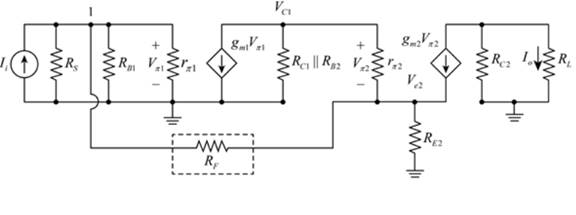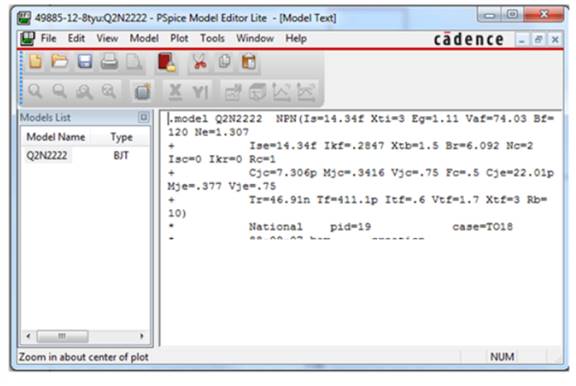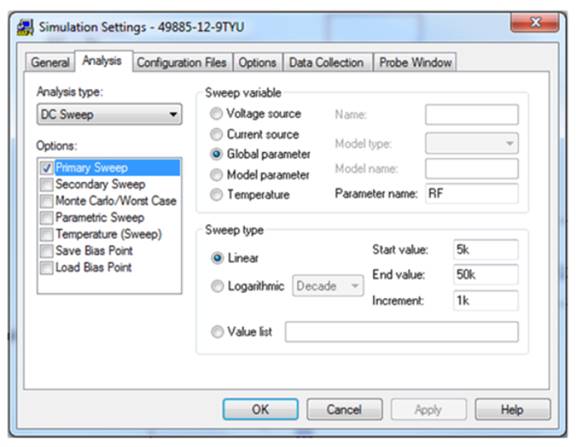
To show: The variation in magnitude of the input resistance
To explain: The influence of
Answer to Problem 12.9TYU
The influence of
Explanation of Solution
Given:
The given diagram is shown in Figure 1

Figure 1
Feedback resistor value is varied between
Calculation:
Mark the nodes and redraw the circuit.
The given diagram is shown in Figure 2

Figure 2
Mark the values and draw the PSpice circuit for the above circuit.
The required circuit is shown in Figure 3

Figure 3
The snip for the drop box of the internal parameters of the transistor is shown in Figure 4

Figure 4
The simulation settings to estimate the magnitude of the current gain as the value of

Figure 5
Then left click on the trace option then select add trace and type “ABS(V(vi)l(li))” then command in the trace magnitude of the resistance

Figure 6
By KCL the expression for the current
The expression for the node voltage is given by,
Apply KCL at node
Substitute
Consider
The expression for the output current is given by,
Substitute
Substitute
Conclusion:
Therefore, the influence of
Want to see more full solutions like this?
Chapter 12 Solutions
Microelectronics: Circuit Analysis and Design
- An open loop Transfer function of unity feedback system is given by G(s)= 1/(s+2)^2 The closed loop transfer function will have poles atarrow_forwardConsider a unity negative feedback system with loop transfer function shown in Figure where L(s)=GcG(s)=K(s2+6s+1)(s2+5s+1) Determine the value of K for which the closed-loop system is stable.arrow_forwardFor the unity feedback system given below, the damping ratio of the closed looppoles is given by a) 1.5 b) 1 c) 0.5 d) 0.25arrow_forward
- The unity feedback system with loop transfer function is given as G(s)G(s)=50/s(s+40). Determine the bandwidth of the closed loop system.arrow_forwardConsider a system with no zeros and only one pole as +5. Place this system in the forward path of a feedback system and add a PD controller in the feedback path with proportional gain 300 and derivative gain 40. Now draw the entire block diagram showing the transfer functions of each block clearly. Then find the closed-loop transfer function of the entire system.arrow_forwardAnalyze the circuit shown in Figure Shown.(i) Determine the type of negative feedback used in the circuit by showingthe suitable process. (ii) Derive the equation for the feedback factor and the gain of the circuit. (ii) Calculate the feedback factor and the gain of the circuit if R1 = 1.2 kΩ,R2 = 15 kΩ and RL = 6.8 kΩ.arrow_forward
- The open-loop transfer function of a unity feedback control system is shown. Select the value of K where the closed-loop system will be stable.arrow_forwardWhat is the importance of TRANSFER FUNCTION in Feedback and contol system. Please discuss.arrow_forwardA unity feedback system with open-loop transfer function given as:?(?) = ??. ?(? + ?)(? + ?)(? + ??)without affecting its operating point (−1.54 ∓ ??2.66) appreciably a- Design a suitable compensator to drive the step response error to zero.b- Design a suitable compensator to reduce step error by factor of 5.arrow_forward
- Find the steady-state error as a function of time for the unity feedback system,..arrow_forwardGiven the following values and shunt-series feedback circuit below, answer the following question: The open loop input resistance of the circuit is: A. 441.18 Ω B. 3035.71 Ω C. 3125 Ω D. 500 Ωarrow_forwardwhat will happen to the feedback fraction and frequency of oscillation of the circuit when the feedback inductor increases?arrow_forward
 Introductory Circuit Analysis (13th Edition)Electrical EngineeringISBN:9780133923605Author:Robert L. BoylestadPublisher:PEARSON
Introductory Circuit Analysis (13th Edition)Electrical EngineeringISBN:9780133923605Author:Robert L. BoylestadPublisher:PEARSON Delmar's Standard Textbook Of ElectricityElectrical EngineeringISBN:9781337900348Author:Stephen L. HermanPublisher:Cengage Learning
Delmar's Standard Textbook Of ElectricityElectrical EngineeringISBN:9781337900348Author:Stephen L. HermanPublisher:Cengage Learning Programmable Logic ControllersElectrical EngineeringISBN:9780073373843Author:Frank D. PetruzellaPublisher:McGraw-Hill Education
Programmable Logic ControllersElectrical EngineeringISBN:9780073373843Author:Frank D. PetruzellaPublisher:McGraw-Hill Education Fundamentals of Electric CircuitsElectrical EngineeringISBN:9780078028229Author:Charles K Alexander, Matthew SadikuPublisher:McGraw-Hill Education
Fundamentals of Electric CircuitsElectrical EngineeringISBN:9780078028229Author:Charles K Alexander, Matthew SadikuPublisher:McGraw-Hill Education Electric Circuits. (11th Edition)Electrical EngineeringISBN:9780134746968Author:James W. Nilsson, Susan RiedelPublisher:PEARSON
Electric Circuits. (11th Edition)Electrical EngineeringISBN:9780134746968Author:James W. Nilsson, Susan RiedelPublisher:PEARSON Engineering ElectromagneticsElectrical EngineeringISBN:9780078028151Author:Hayt, William H. (william Hart), Jr, BUCK, John A.Publisher:Mcgraw-hill Education,
Engineering ElectromagneticsElectrical EngineeringISBN:9780078028151Author:Hayt, William H. (william Hart), Jr, BUCK, John A.Publisher:Mcgraw-hill Education,





